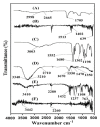Formulation and In-Vitro Characterization of pH-Responsive Semi-Interpenetrating Polymer Network Hydrogels for Controlled Release of Ketorolac Tromethamine
- PMID: 34698162
- PMCID: PMC8544598
- DOI: 10.3390/gels7040167
Formulation and In-Vitro Characterization of pH-Responsive Semi-Interpenetrating Polymer Network Hydrogels for Controlled Release of Ketorolac Tromethamine
Abstract
Ketorolac tromethamine is a non-steroidal anti-inflammatory drug used in the management of severe pain. The half-life of Ketorolac tromethamine is within the range of 2.5-4 h. Hence, repeated doses of Ketorolac tromethamine are needed in a day to maintain the therapeutic level. However, taking several doses of Ketorolac tromethamine in a day generates certain complications, such as acute renal failure and gastrointestinal ulceration. Therefore, a polymeric-controlled drug delivery system is needed that could prolong the release of Ketorolac tromethamine. Therefore, in the current study, pH-responsive carbopol 934/sodium polystyrene sulfonate-co-poly(acrylic acid) (CP/SpScPAA) hydrogels were developed by the free radical polymerization technique for the controlled release of Ketorolac tromethamine. Monomer acrylic acid was crosslinked with the polymers carbopol 934 and sodium polystyrene sulfonate by the cross-linker N',N'-methylene bisacrylamide. Various studies were conducted to evaluate and assess the various parameters of the fabricated hydrogels. The compatibility of the constituents used in the preparation of hydrogels was confirmed by FTIR analysis, whereas the thermal stability of the unreacted polymers and developed hydrogels was analyzed by TGA and DSC, respectively. A smooth and porous surface was indicated by SEM. The crystallinity of carbopol 934, sodium polystyrene sulfonate, and the prepared hydrogels was evaluated by PXRD, which revealed a reduction in the crystallinity of reactants for the developed hydrogels. The pH sensitivity of the polymeric hydrogel networks was confirmed by dynamic swelling and in vitro release studies with two different pH media i.e., pH 1.2 and 7.4, respectively. Maximum swelling was exhibited at pH 7.4 compared to pH 1.2 and, likewise, a greater percent drug release was perceived at pH 7.4. Conclusively, we can demonstrate that the developed pH-sensitive hydrogel network could be employed as a suitable carrier for the controlled delivery of Ketorolac tromethamine.
Keywords: carbopol 934; hydrogel; ketorolac tromethamine; sodium polystyrene sulfonate.
Conflict of interest statement
The authors declare no conflict of interest.
Figures








Similar articles
-
Preparation, Characterization, Swelling Potential, and In-Vitro Evaluation of Sodium Poly(Styrene Sulfonate)-Based Hydrogels for Controlled Delivery of Ketorolac Tromethamine.Pharmaceuticals (Basel). 2021 Apr 9;14(4):350. doi: 10.3390/ph14040350. Pharmaceuticals (Basel). 2021. PMID: 33918921 Free PMC article.
-
Fabrication of pH responsive hydrogel blends of chondroitin sulfate/pluronic F-127 for the controlled release of ketorolac: its characterization and acute oral toxicity study.Drug Dev Ind Pharm. 2022 Nov;48(11):611-622. doi: 10.1080/03639045.2022.2150773. Epub 2022 Nov 30. Drug Dev Ind Pharm. 2022. PMID: 36420771
-
In Vitro Evaluation of Smart and pH-Sensitive Chondroitin Sulfate/Sodium Polystyrene Sulfonate Hydrogels for Controlled Drug Delivery.Gels. 2022 Jun 25;8(7):406. doi: 10.3390/gels8070406. Gels. 2022. PMID: 35877491 Free PMC article.
-
In-vitro and in-vivo evaluation of biocompatible polymeric microgels for pH- driven delivery of Ketorolac tromethamine.Int J Pharm. 2022 Oct 15;626:122194. doi: 10.1016/j.ijpharm.2022.122194. Epub 2022 Sep 14. Int J Pharm. 2022. PMID: 36113744
-
Ketorolac, an injectable nonnarcotic analgesic.Clin Pharm. 1990 Dec;9(12):921-35. Clin Pharm. 1990. PMID: 2292174 Review.
Cited by
-
Effect of Co-Solvents, Modified Starch and Physical Parameters on the Solubility and Release Rate of Cryptotanshinone from Alcohologels.Molecules. 2024 Dec 12;29(24):5877. doi: 10.3390/molecules29245877. Molecules. 2024. PMID: 39769966 Free PMC article.
-
In Vitro Evaluation of Kaempferol-Loaded Hydrogel as pH-Sensitive Drug Delivery Systems.Polymers (Basel). 2022 Aug 5;14(15):3205. doi: 10.3390/polym14153205. Polymers (Basel). 2022. PMID: 35956719 Free PMC article.
-
Crosslinked PVA-g-poly(AMPS) Nanogels for Enhanced Solubility and Dissolution of Ticagrelor: Synthesis, Characterization, and Toxicity Evaluation.ACS Omega. 2024 May 2;9(19):21401-21415. doi: 10.1021/acsomega.4c01721. eCollection 2024 May 14. ACS Omega. 2024. PMID: 38764664 Free PMC article.
-
Compression-coated pulsatile chronomodulated therapeutic system: QbD assisted optimization.Drug Deliv. 2022 Dec;29(1):2258-2268. doi: 10.1080/10717544.2022.2094500. Drug Deliv. 2022. PMID: 35838522 Free PMC article.
-
Environmental and Wastewater Treatment Applications of Stimulus-Responsive Hydrogels.Gels. 2025 Jan 16;11(1):72. doi: 10.3390/gels11010072. Gels. 2025. PMID: 39852043 Free PMC article. Review.
References
-
- Jeganath S., Asha D., Kumar S.S., Nair K.S., Kumaran K.S. Oral Controlled Drug Delivery System—A Review. Res. J. Pharm. Technol. 2018;11:797–804. doi: 10.5958/0974-360X.2018.00151.8. - DOI
-
- Khan S., Minhas M.U., Ahmad M., Sohail M. Self-assembled supramolecular thermoreversible beta-cyclodextrin/ethylene glycol injectable hydrogels with difunctional Pluronic((R))127 as controlled delivery depot of curcumin. Development, characterization and in vitro evaluation. J. Biomater. Sci. Polym. Ed. 2018;29:1–34. doi: 10.1080/09205063.2017.1396707. - DOI - PubMed
Grants and funding
LinkOut - more resources
Full Text Sources
Miscellaneous

